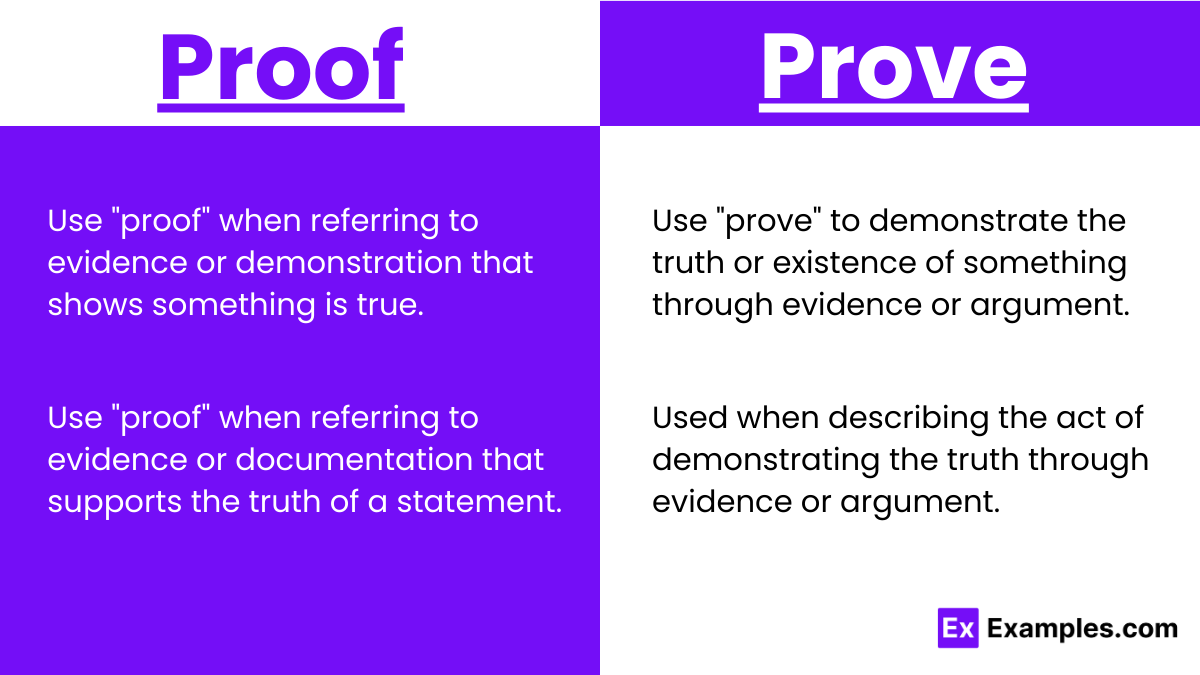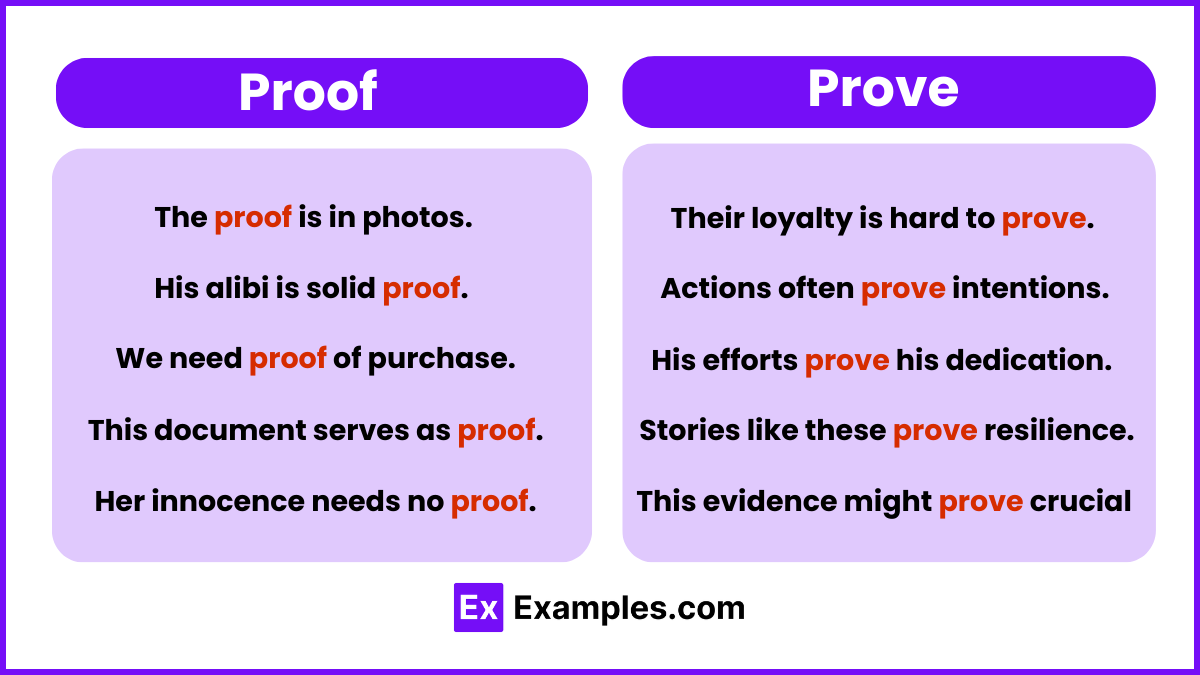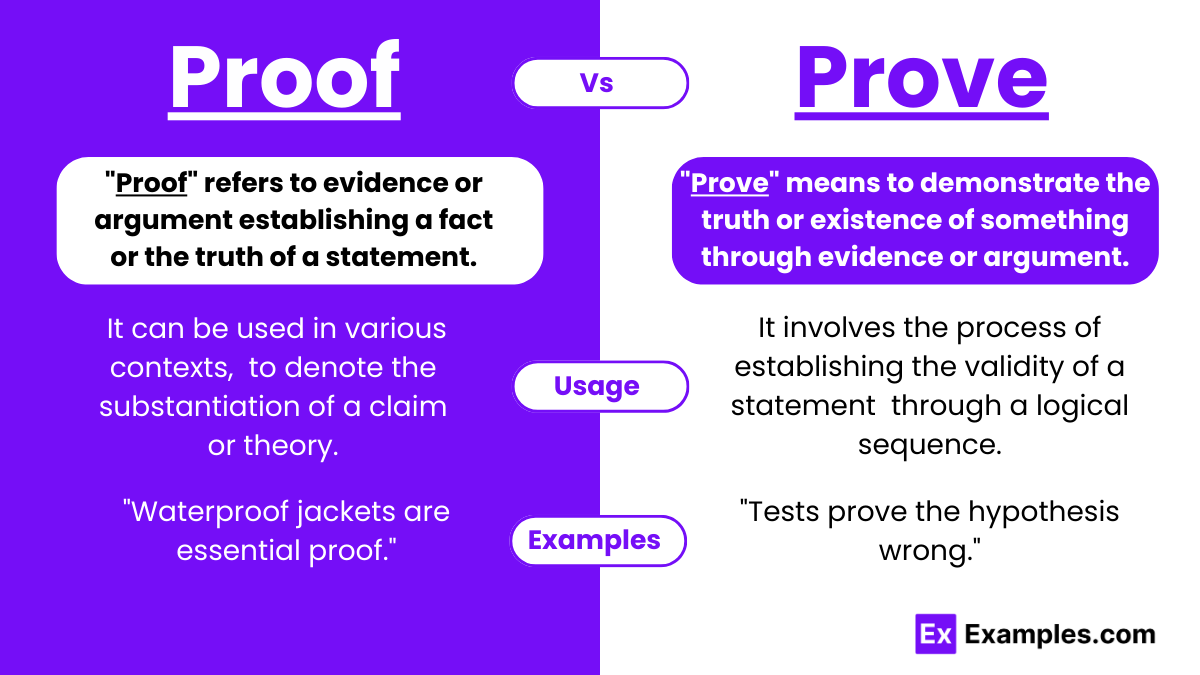Proof vs Prove – Meanings, Differences, Usage, Examples
In the dance of English vocabulary, “proof” and “prove” are partners with a common Latin lineage, stemming from “probare,” yet they step to different beats. “Proof,” a noun, embodies evidence or verification that asserts a fact or truth. Meanwhile, “prove,” a verb, is the act of establishing truth or validity, like solving a mystery. This article twirls through the nuances of these terms, spotlighting their distinct roles in the language ballet, ensuring you’ll never miss a step in their use again.
Proof and Prove – Meanings
- Proof: As a noun, “proof” refers to evidence or argument establishing a fact or the truth of a statement. It can be used in various contexts, such as legal, scientific, and mathematical, to denote the substantiation of a claim or theory.
- Prove: “Prove” is a verb that means to demonstrate the truth or existence of something through evidence or argument. It involves the process of establishing the validity of a statement or hypothesis, often through a logical sequence or experimental verification.
Summary
Proof is the evidence or demonstration that confirms the validity of a statement or claim. For instance, a scientist might present proof of a new discovery in a research paper. On the other hand, to prove something means to establish its truth through evidence or argument, like when a lawyer aims to prove a client’s innocence in court. Remember, “proof” (with an “f”) is the noun form referring to the evidence, while “prove” (with a “ve”) is the verb form indicating the act of establishing truth.
How to Pronounce Proof and Prove
- Proof: Pronounced as /pruːf/ (proo-f).
- Prove: Pronounced as /pruːv/ (proo-v).
Despite their pronunciation similarities, their distinct grammatical roles—noun vs. verb—help clarify their usage in sentences.
Differences between Proof and Prove
| Aspect | Proof | Prove |
|---|---|---|
| Part of Speech | Noun | Verb |
| Function | Serves as evidence or verification | Act of demonstrating truth or validity |
| Example Context | “The scientist presented proof of the theory.” | “She aims to prove her hypothesis in the experiment.” |
| Temporal Reference | Can be presented at any point as substantiation | Often involves a process or sequence of actions |
| Effect on Reader/Listener | Conveys a sense of conviction or confirmation | Implies action and the process of verification |
| Nuance in Sentence | Indicates the presence of evidence | Focuses on the action of validating or testing |
How to Remember the Difference between Proof and Prove
To distinguish between “proof” and “prove,” consider that “proof” (with the “f”) refers to the final evidence or result (both contain “f”), while “prove” (ending in “ve”) involves the action or process of verifying, similar to other verbs like “move” or “remove.”
When to Use Proof and Prove

Usage of Proof
- Noun: Use “proof” when referring to evidence or demonstration that shows something is true. For example, “The mathematical proof confirmed the theorem.”
- Verb: In a non-standard or specialized context, particularly in publishing or baking, “proof” can be a verb. In publishing, it means to check for errors (“proofreading”), and in baking, it refers to allowing dough to rise (“proofing the dough”).
- Use “proof” when referring to evidence or documentation that supports the truth of a statement or claim.
- “Proof” is used in contexts where the focus is on the result of verification, such as scientific proof, legal proof, or mathematical proof.
- It can also denote a level of alcohol content in beverages or resistance, as in “waterproof.”
Usage of Prove
- Verb: Use “prove” when you need a verb to demonstrate the truth or existence of something through evidence or argument. For example, “The scientist aims to prove the hypothesis through experiments.”
- Conjugation: “Prove” changes form to “proved” (past tense) and “proven” or “proved” (past participle) depending on the tense. For example, “She proved her point” (past tense) and “The theory has been proven” (past participle).
- Use “prove” when describing the act of demonstrating the truth or validity of something through evidence or argument.
- “Prove” is common in research, legal, and everyday contexts where verification or testing is involved.
- It can also mean to turn out or to be found by experience, as in “The method proved effective.”
How to use Proof and Prove
Proof
- How to Use: You provide proof when you offer evidence supporting a claim, like showing documents to prove identity.
- Verifiability: “The experiment provided irrefutable proof of the new theory.”
- Documentation: “She had all the proof needed to validate her claim.”
- Certainty: In discussions, to convey certainty or evidence (“This is the proof you asked for”).
Prove
- How to Use: You prove something by demonstrating its truth through evidence or logical argument, such as proving a theorem in mathematics.
- Verification: “The scientist aims to prove the hypothesis in her next experiment.”
- Testing: “We need to prove this software’s reliability before launch.”
- Validation: “The lawyer set out to prove his client’s innocence.”
Proof and Prove – Examples

Examples of Proof
- Present: “I proof the dough in a warm area before baking.”
- Past: “She proofed her article meticulously before submission.”
- Present Participle: “He is proofing the document for any errors.”
- “His passport served as proof of citizenship during the application process.”
- “The waterproof jacket was a perfect proof against the heavy rain.”
Examples of Prove
- Present: “They prove their theory with extensive experiments.”
- Past: “He proved his innocence with undeniable evidence.”
- Past Participle: “The hypothesis has been proven correct through research”
- “He proved to be a reliable friend in times of need.”
- “The experiment aimed to prove the correlation between the variables.”
Synonyms
| Proof | Prove |
|---|---|
| Evidence | Demonstrate |
| Confirmation | Verify |
| Verification | Establish |
| Corroboration | Confirm |
| Validation | Substantiate |
Exercise
- The DNA evidence was the crucial ________ in the case.
- She wanted to ________ her theory with experimental data.
- His alibi provided solid ________ of his whereabouts.
- The scientist managed to ________ a significant correlation between the two phenomena.
- The waterproof coating is effective ________ against moisture.
Answers
- proof
- prove
- proof
- prove
- proof
FAQ’S
Is it a proof or a prove?
“Proof” is a noun meaning evidence, while “prove” is a verb meaning to demonstrate or establish the truth.
How do you use proof and prove in a sentence?
Use “proof” as a noun: “The scientist presented proof of the theory.” Use “prove” as a verb: “She wants to prove her hypothesis.”
How do you use proof?
“Proof” is used to refer to evidence or demonstration: “The proof of his innocence was undeniable.”
Is it I want to proof or prove?
The correct form is “I want to prove,” indicating the desire to demonstrate or establish the truth.
Why do people say proof?
People say “proof” to refer to evidence or validation that supports a claim, argument, or hypothesis.
What are the 3 forms of proof?
The three forms of “prove” are: Base (prove), Past (proved), and Past Participle (proven or proved).


